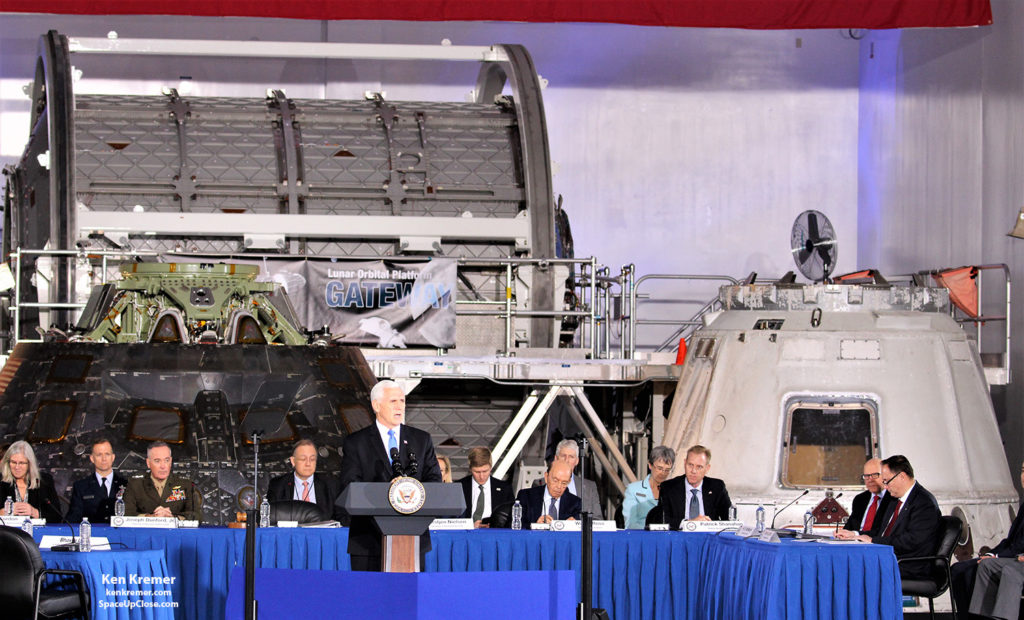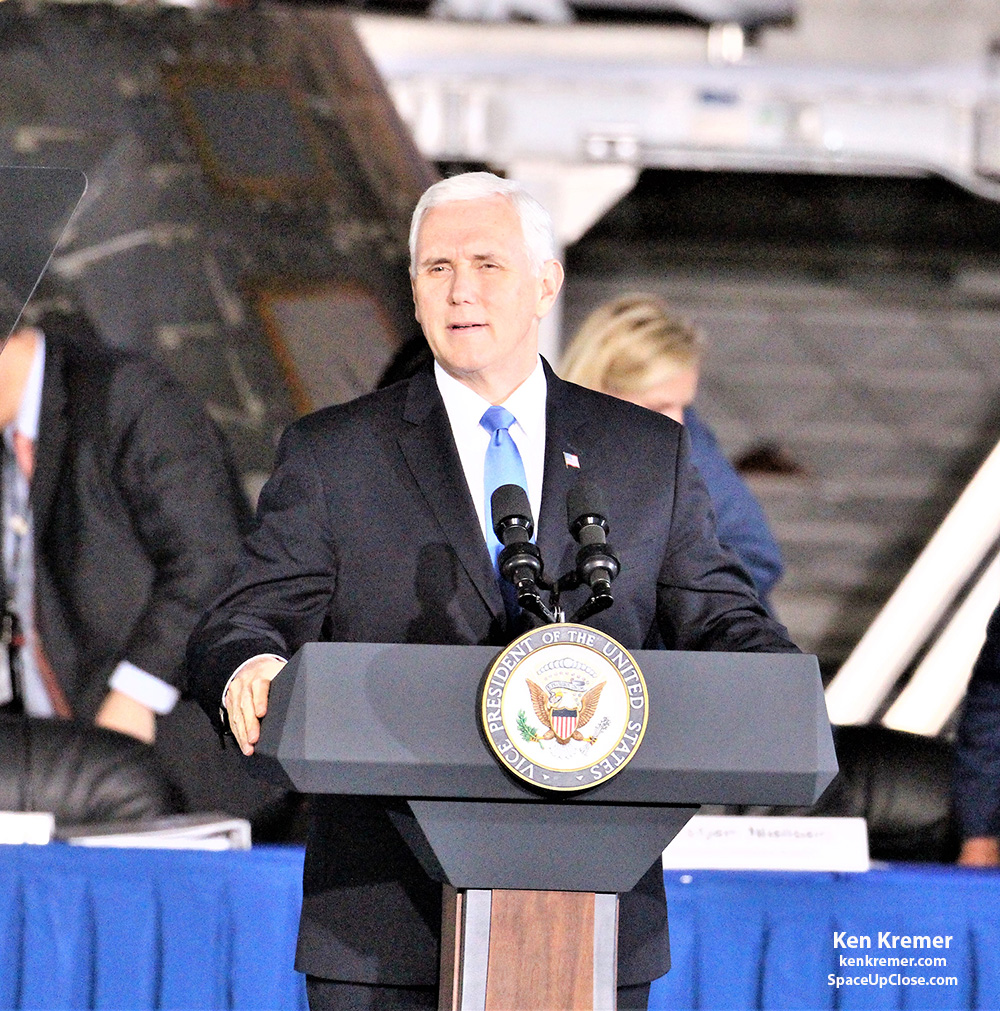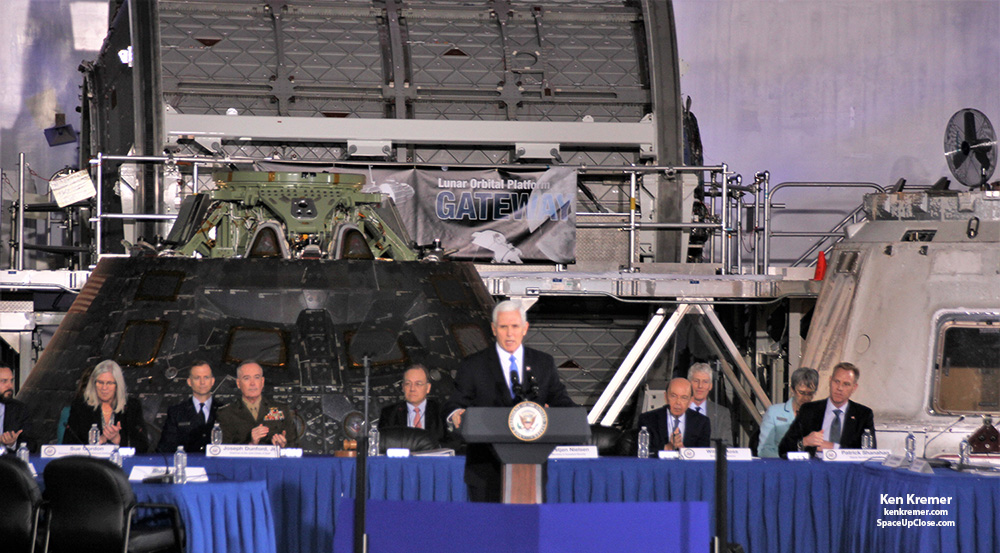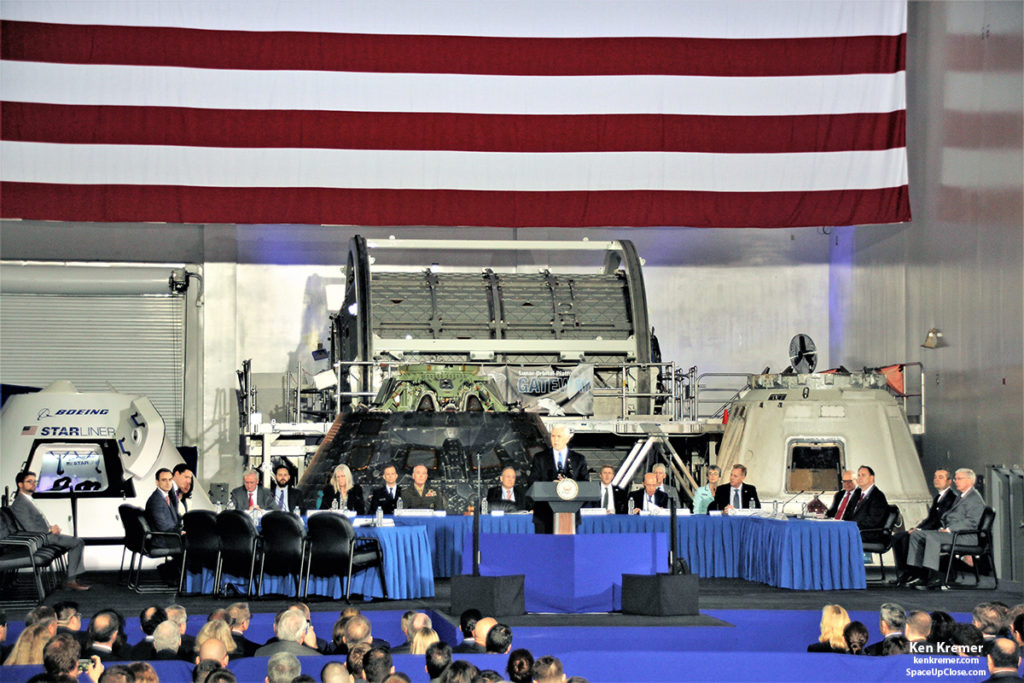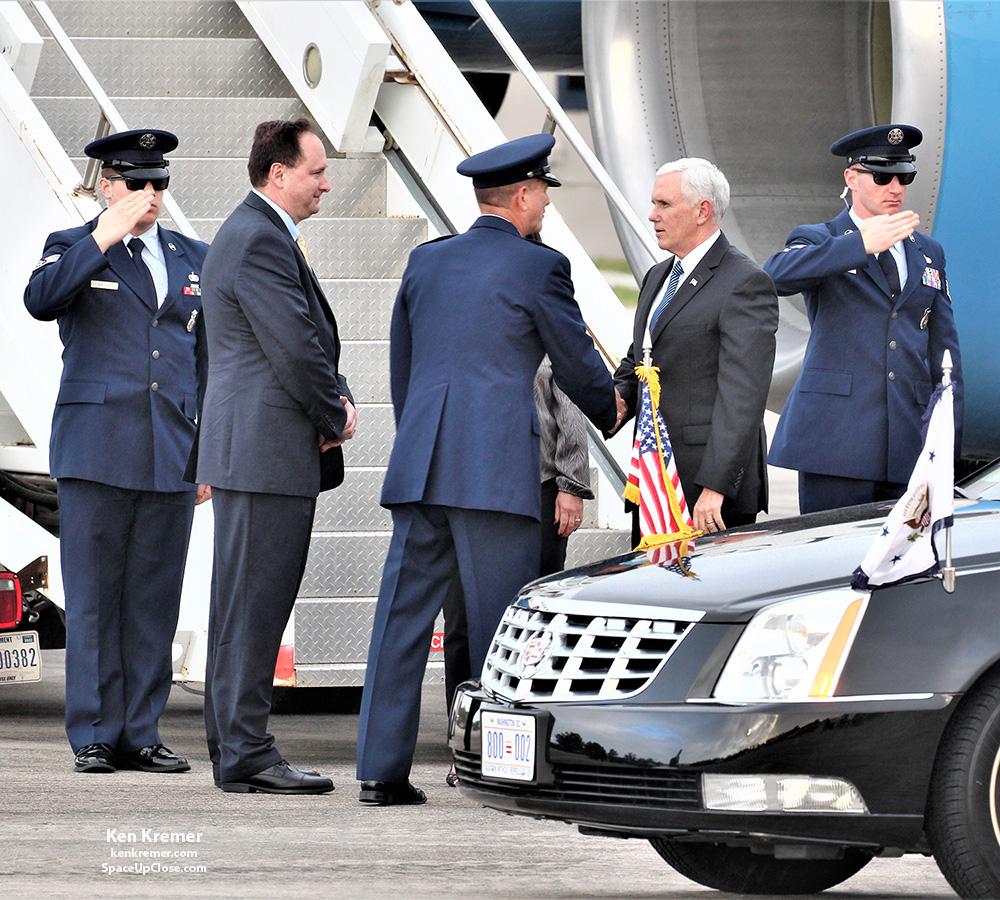Ken Kremer
— SpaceUpClose.com — 21 Feb 2018
SPACE CENTER, FL – Vice President Mike Pence
came to the Florida Space Coast this week and hosted a high powered meeting of the
National Space Council at NASA’s Kennedy Space
Center (KSC) in Florida, on Wednesday Feb. 21, 2018. The Space Summit focused
on fostering the nation’s commercial space activities as well as reaffirming
President Trump’s support for NASA’s plan to return American astronauts to the
Moon in the 2020s.
Council meeting was held in the high bay of the Space Station Processing
Facility at KSC and attended by high ranking representatives from civil space,
commercial space and national security space from the US government as well as
industry representatives including the Chairman of the Joint Chiefs of Staff
Admiral Joseph
Dunford, the US National
Security Advisor H.R. McMaster and NASA’s acting Administrator Robert Lightfoot,
among others.
stands ‘at the birth of a new millennium, ready to unlock the mysteries of
space’ – and after the first year of our administration, the record is clear:
under President Trump, America is leading in space once again,” – Vice
President Mike Pence declared in his opening speech to the National Space
Council at KSC.
Pence flew in from Washington D.C, aboard Air
Force 2 arriving at the Shuttle Landing Facility (SLF) the evening before on
Tuesday, Feb. 20 around 5 p.m. EST.
the Trump Administration’s “Moon, Mars, and Worlds Beyond” initiative.
variety of “leaders in the civil, commercial and national security sectors
about the importance of the United States’ space enterprise.”
by the NASA Orion, Boeing Starliner and SpaceX Dragon crew vehicle hardware
currently under development to restore American access to space, seated inside
American spaceships launching atop American rockets from American soil here at
the Kennedy Space Center.
after the Trump Administration proposed a NASA budget request of $19.9 Billion
for Fiscal Year 2019 – with
a goal of returning Americans to the Moon in the next decade. That amounts to
barely a 2% increase over FY 2018.
hindering private enterprises efforts to exploit space and he appeared to take
copious notes from the presentations by the various council members and two
panels of experts.
bureaucratic obstacles and outdated regulatory processes. Today’s launch licensing regime is plagued by
burdensome government barriers,” Pence said. “Government launch licenses can’t
be transferred from one site to another.”
Kennedy Space Center but then wants to move their mission to California or even
just a few miles away from Cape Canaveral, that same company must complete the entire
process all over again.”
figured out how to honor drivers licenses across state lines, there’s no reason
we can’t do the same for rockets.”
This was the second meeting of the
reconstituted National Space Council which has been reactivated under the Trump
Administration after lying dormant for about 25 years since 1993.
Council, an organization of vital importance to America’s future in space that
had laid dormant for a quarter of a century,” Pence said.
Pence was named by President Trump to lead the
National Space Council after signing an executive order to reestablish the
group on June 30, 2017.
provide policy recommendations to the President to streamline the regulatory
environment for commercial space companies.”
“to reform the commercial space regulatory frameworks at the Departments of
Transportation and Commerce.”
from the KSC Space Summit:
work to transform the launch and re-entry licensing regime.
license for all types of launch and re-entry vehicle operations and transform
the launch and re-entry regulatory process from one of prescriptive
requirements to a performance based licensing regime.
consolidate its space commerce responsibilities, other than launch and reentry,
in the Office of the Secretary of Commerce.
proposal to create an Under Secretary of Space Commerce, who would be
responsible for all commercial space regulatory functions.
Information Administration should coordinate with the Federal Communications
Commission to ensure the protection and stewardship of radio frequency spectrum
necessary for commercial space activities.
commercial space activity should not adversely affect national security or
public safety.
Space Council, in coordination with members of the National Space Council,
should initiate a policy review of the current export licensing regulations
affecting commercial space activity
the president on America’s space policy and strategy, and review the nation’s
long-range goals for space activities.”
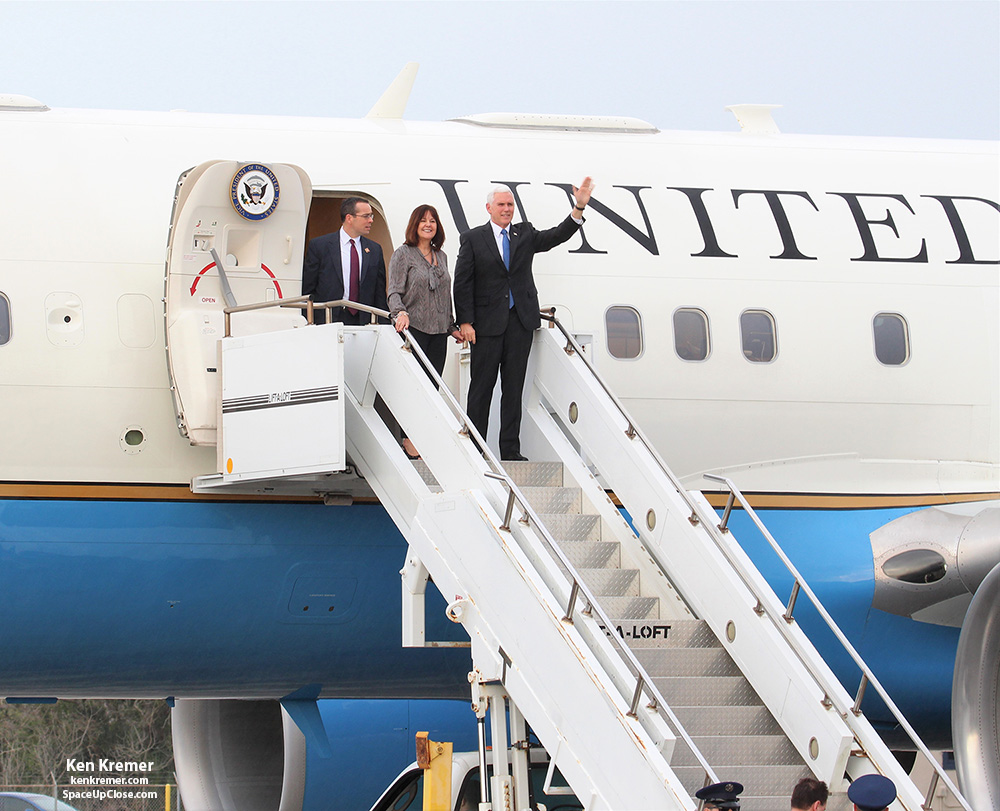 |
|
Vice President
Mike Pence and his wife Karen arrived at NASA’s Kennedy Space Center in Florida on Air Force 2 on Feb. 20, 2018, to chair a meeting of the National Space Council on Feb 21. Credit: Ken Kremer/SpaceUpClose.com/kenkremer.com
The Vice President also took a detailed tour of
NASA KSC, Cape Canaveral Air Force Station and private industrial space facilities from ULA and Blue Origin for an up close look at the burgeoning space activities sparking a long sought and hoped for revival of America’s premier spaceport.
The VP’s tour was led by acting NASA
Administrator Robert Lightfoot and KSC Director and former shuttle commander Robert Cabana.
Pence visited the ULA Delta IV Heavy rocket being
prepared to launch NASA’s Parker Solar Probe in July, on a tour led by ULA CEO Tory Bruno.
Read our related stories about the FY 2019 NASA
budget proposal and plans by Trump to end all funding for the ISS after 2024 – a shortsighted move that threatens the outposts future if commercial tenants can’t be found willing to spend untold billions of dollars in upkeep and support.
Watch for Ken’s continuing onsite coverage of NASA, SpaceX,
ULA, Boeing, Lockheed Martin, Orbital ATK and more space and mission reports direct from the Kennedy Space Center and Cape Canaveral Air Force Station, Florida.
Stay tuned here for Ken’s continuing
Earth and Planetary science and human spaceflight news: www.kenkremer.com –www.spaceupclose.com – twitter @ken_kremer – ken at kenkremer.com |


